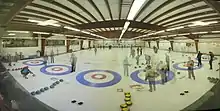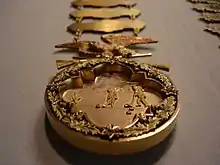Utica Curling Club
The Utica Curling Club is located in Utica, New York. The club was founded in 1868 and is one of the oldest curling clubs in the United States. A member of the Grand National Curling Club (GNCC), the Utica Curling Club is the largest curling club on the East Coast, and has 6 sheets of ice and over 200 members.
| Utica Curling Club | |
|---|---|
| Location | 8300 Clark Mills Road Whitesboro, New York 13492-3912 |
| Information | |
| Established | 1868 |
| Club type | Dedicated ice |
| USCA region | Grand National Curling Club |
| Sheets of ice | Six |
| Website | http://www.uticacurlingclub.org |
History
- 1832 Outdoor curling began on a frozen pond in Clark Mills, New York
- 1868 Utica Curling Club is founded
- 1890 An enclosed curling shed was constructed
- 1911 Mitchell Bonspiel played for the first time
- 1916 An indoor club was built on Francis Street in Utica, New York
- 1995 The Francis Street club was destroyed by fire
- 1996 A new facility opened at 8300 Clark Mills Road, Whitesboro, New York

The Erie Canal had just opened up the West, and the Age of Immigration was beginning. Thousands were coming to America from the British Isles and Europe drawn by the promise of food, jobs, and prosperity. The Mohawk Valley, with its abundance of water-power and its strategic location in relation to transportation, was on the leading edge of industrialization. The population of the area was growing rapidly, and two out of three Uticans were born in foreign countries or were children of immigrants. In this great "Melting Pot", the heritage of these new Americans tempered the area with new traditions and customs. The earliest recorded curling events locally were organized by Scotch and English textile workers in Clark Mills in 1832. In 1855, the sport moved to lower Campbell Pond (now Twin Ponds) in New York Mills where it flourished for more than 20 years. Many Uticans were part of this group and traversed the three mile distance in horse drawn sleds.
Benjamin Allen, who arrived from England in 1832, was an expert stone-cutter and worked on the Erie Canal Expansion, the Chenango Canal and various other building projects. He was an avid curler that participated in the games held on the Chenango Canal, the Globe Mill Pond in West Utica, Butterfield skating rink on Jewett Street, on the Erie Canal, and sometimes on the Mohawk River flats.
Allen purchased property that contained Ballou Creek where it emptied into the Erie Canal. By damming the shallow section of the creek near Rutger Street, he was able to form a large ice surface that could be used for curling and ice skating. In 1868, he formed the Utica Curling club. In 1874, the rink area was fenced in and a small shed with wood-burning stove was built. That same year, the New York Mills Curling Club merged with Utica and joined the Grand National Curling club as the Utica Curling Club.
To reduce the shoveling that curling outdoors required, a large building was erected in 1891-92 that could house 3 sheets of curling ice under cover and could also be used for skating. Refrigeration was provided by opening the large windows on three sides of the building. It was known as Rutger Rink and was home of the Utica Curling Club until 1916.
The facility was willed to the Utica Curling Club by Benjamin Allen's son, W. Fred. In 1916, the city of Utica, looking to expand its boundaries and expand Rutger Street eastward, paid the Club nearly $20,000 for the building and property. The club bought property on Francis Street and began construction on the new Clubhouse in October 1916. The building housed 5 sheets of ice and again, refrigeration was provided (or withheld) by Mother Nature through large windows in the curling shed. Even though no curling clubs had artificial ice prior to World War I, A.S. Brinckerhoff, a member of the building committee and long time ice chairman of the old Rutger Rink, had insisted that a basement room in the new Francis Street building be designed to hold equipment for ice-making.
By 1923, the membership limit of 180 had been reached and a waiting list established. Then came two disastrous winters of thaws, uncompleted schedules, and wrecked bonspiels. The natural decision followed - an artificial ice plant was installed. As a result of old "Brink's" foresight, when the York Ice Machinery Co. made the installation in 1925, not a single change had to be made in the basement to accommodate the equipment.
The depression of 1930-39 demanded rigid economy and required individual financial aid to tide over some unbalanced budgets, but curling never declined. In the early forties, women relatives of club members got permission to use the ice, when available, for fifty cents per person per game. In 1948, on behalf of women relatives and friends, Marjorie Foster submitted a report of the women’s activities, and in September 1948, the men voted to accept the women as associate members. The women’s organization, first led by Marge Foster, was originally named the Utica Tartans, but in 1949 changed their name to the Utica Glengarries. The invitation of women to curl gave the club its most pronounced increase in membership. Women became full membershs with voting privileges in 1990. Read a full history of the Glengarries.
(women did not gain full membership and voting privileges until 1990). Mixed curling became a staple of the club, and our famous Mixed Bonspiel was started in 1953. Teenagers began to curl in 1954; Little Rockers (ages 6–12) in 1989.
The original Glengarry pin, affectionately known as the “stick lady” was designed by a charter Glengarries member, Lynda More. At the same time, she created a companion pin for the men. Both were curling stone stick figures with a U for Utica surrounding the figure. After a few years, the Lynda created a second pin for Glengarries to trade at bonspiels. It is a shield in white, blue, and gold, with a Glengarry hat, crossed brooms, a stone, and a thistle. Mixed curling became a staple of the club, and our famous Mixed Bonspiel was started in 1953, so a mixed pin was created, combining the male and female heads on a single pin.
A major expansion was undertaken in 1958-59, which was also the first time that all five sheets had matched stones. In 1962 a new ice base was installed, with indirect refrigeration which removed the hazard of pressurized ammonia gas inside the curling shed. The interior was upgraded in 1975 and 76 (paneling and modern kitchen). Most importantly, our stones were replaced at the start of the 1985-86 season with the new Ailsa Craig insert stones with modern plastic handles.
In 1995, the Francis Street club was destroyed by fire. But by 1996, a new facility with 6 sheets of ice had opened on Clark Mills Road in Whitestown. In honor of this "resurrection from the ashes”, Tom Garber designed a new Phoenix logo and pin. Since then the building has been modified for wheelchair curlers and others with disabilities. The new facility has been host to the U.S. men’s and women’s championships, the U.S. club championships, the college national championships, and in 2011 celebrated the 100th anniversary of hosting the Mitchell Bonspiel, an international men’s Grand National Curling Club event first held in 1885. The Utica Curling Club now sports almost 300 members embracing novices, long-time curlers, juniors, college curlers, and wheelchair curlers. Teenagers began curling in 1954; Little Rockers (ages 6-12) in 1989. College curling, which had been sporadic, became a permanent addition in 2005 when Hamilton College and Colgate University formed their curling clubs and made the Utica rink their home. SUNY Polytechnic Institute joined in 2015 and we have had representatives from SUNY Binghamton, Syracuse University, Utica College, Cornell University, and Mohawk Valley Community College.
Curling has undergone many changes at Utica in the last 149 years. But the Spirit of Curling remains strong as the Utica Curling Club looks forward to its sesquicentennial in 2018.
Bonspiels
- Mitchell Mens

An international invitational bonspiel, founded by Alexander Mitchell, patron of the Grand National, who placed the medal into competition in Feb. of 1885. Alexander Mitchell, a Scot from Aberdeenshire, moved to Milwaukee in 1839 as the representative of a Scottish insurance company. He became a leading banker, industrialist and later on became President of the Chicago, Milwaukee & St. Paul Railway. In December 1884, he donated the Mitchell Gold Medal for annual competition to be "played in the Eastern and Western sections alternately with the Gordon Champion Rink Medal." Mr. Mitchell died of pneumonia in the spring of 1887 and the last Western Competition was held in St. Paul in February 1898. After that it was held only in the East, and in 1916, it was decided to make the Utica Curling Club the permanent host of the bonspiel.
There are six events with a four-game guarantee. The 2011 Mitchell was the 126th overall and the 100th to be held at the Utica Curling Club.
- Cobb Mixed
An international invitational bonspiel with extensive social activities for out-of-town teams and selected Utica teams (based on performance in the Mixed Championship). There are six medal events. Trophy presentations: President's Cup, winner of the first event; Curler's Cooler, runner-up of the first event; Silver Tassie, winner of the second event; The Ice Box, winner of the third event; and Friendship Trophy, winner of the fourth event.
References
Drawn from the booklet created by Tom Garber for the 125th anniversary of the club, "A Half Century with the Glengarries" by Anne Burchesky, and club archives.